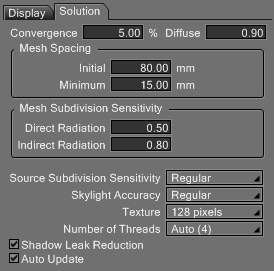Radiosity Settings
Open the Radiosity Settings by clicking the Show/Hide button in the top left of the Radiosity Window. The settings are divided into two tabs: Display and Solution.
Display Tab
This tab is used to specify how the radiosity calculation result is displayed in the Radiosity Window. You can confirm changes to settings without re-calculation, except for the items related to the display settings performed during Radiosity calculation.

- Mesh
- The mesh outline is displayed in wireframe mode. This wireframe display allows you to confirm how the mesh is subdivided.
- Solid
- Objects are displayed with solid surfaces. This enables you to confirm the actual Radiosity calculation result.
- Texture
- Objects are displayed with textures. This feature is available in Shade3D Professional.
- Cull-face
- Culls the display of back surfaces of objects. This enables you to see a closed scene, such as the inside of a room, from the outside.
- Blend
- Objects whose transparency was set with surface attributes will appear transparent.
- Radiator
- Light sources and/or areas that radiate light, both of which are subject to radiation calculation, are drawn in red wireframe during radiosity calculation.
- Update Every X Shoot(s)
- This specifies how the light sources and/or areas that radiate light, both of which are subject to radiation calculation, are drawn in red wireframe during the radiosity calculation. It indicates after how many calculations the wireframe will be updated.
Solution Tab
This tab is used to specify the settings related to the method of Radiosity solution. Changes to these settings are applied when recalculating the Radiosity solution.

- Convergence
- This text box is used to complete the radiosity calculation when its progress has reached the entered ratio.
- Diffuse
- The value entered in this text box is multiplied by the value of the Diffuse parameter in the Surface Window, and the result is displayed in the Radiosity Window to perform the calculation. This value will significantly affect the indirect light.
- Mesh Spacing Settings
- In connection with the setting of mesh subdivision sensitivity, you can set the calculation precision (mesh subdivision precision) of a surface that receives light. The mesh subdivision is automatically performed based on the magnitude of energy residing at the vertices of polygons. In setting the mesh spacing, the initial mesh spacing and the minimum mesh spacing are the values with which the automatic mesh subdivision is initiated and terminated, respectively.
- Initial
- Enter the initial value of mesh spacing with which the mesh subdivision starts. The units specified in the Units popup menu of the Figure menu apply to this value.
- Minimum
- Enter the minimum value of mesh spacing with which the mesh subdivision is performed. The units specified in the Units popup menu of the Figure menu apply to this value.
- Mesh Subdivision Sensitivity
- In connection with the mesh spacing setting, you can set the calculation precision of surfaces that receive light. These settings control how the automatic mesh subdivision is performed in terms of indirect and direct energy.
- Direct Energy
- Sets how the automatic mesh subdivision is performed in terms of direct radiation. With a higher sensitivity value, meshes are automatically subdivided for even small differences in the amount of energy received by adjacent mesh vertices.
- Indirect Energy
- Sets how the automatic mesh subdivision is performed in terms of indirect radiation. With a higher sensitivity value, meshes are automatically subdivided for even small differences in the amount of energy received by adjacent mesh vertices.
- Source Subdivision Sensitivity
- Sets the calculation precision (mesh subdivision precision) of surfaces that emit light. These surfaces, like the surfaces that receive light, will be automatically subdivided based on the differences in the amount of energy at the mesh vertices. This setting specifies how surfaces are automatically subdivided.
- Skylight Accuracy
- Sets the precision of shadows produced by skylight. Skylight is used to simulate diffused reflection of sunlight by equally dividing the sky sphere both latitudinally and longitudinally and using parallel light from each subdivision. The accuracy of the skylight calculation depends on the number of subdivisions of the sphere. If the intensity of the distant light very low, rendering of the shadows generated by skylight may be imprecise. Set the intensity and colors of the skylight from the Distant Light Window.
- Texture
- Sets how textures are calculated based on properties set up in the Surface Window. The applicable texture is a single layer material.
- Number of Threads
- Available in Shade3D Professional. Specifies the number of threads used for the radiosity calculation.
- Shadow Leak Reduction
- Shadow leaks are automatically checked for to prevent them from occurring. However, you may not get the expected results, depending on how the objects were created. Therefore, please try to create the objects so as to avoid shadow leaks.
- Auto Update
- This option is available in "Radiosity Pro" provided in Shade3D Professional. If this checkbox is selected when an operation adapted for updating is performed, the Radiosity Window is automatically updated.